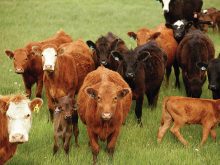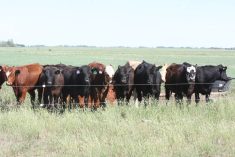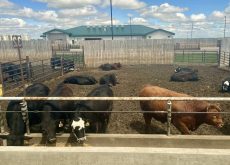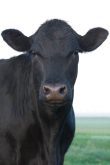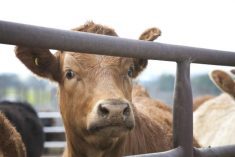Canada’s food safety agency is still tracking down herdmates of the country’s 19th domestic case of BSE, but will otherwise assume the Alberta cow most likely caught the disease from trace proteins in its early feed.
The Canadian Food Inspection Agency on Nov. 30 submitted its final report on Case 19 — a 70-month-old purebred black Angus beef cow — to the World Organization for Animal Health (OIE), and describes the case as “resolved.”
A feed-borne infection is “likely the source” of BSE (bovine spongiform encephalopathy) in Case 19, Dr. Martine Dubuc, CFIA’s chief food safety officer, said in the report.
Read Also

Pig transport stress costs pork sector
Popular livestock trailer designs also increase pig stress during transportation, hitting at meat quality, animal welfare and farm profit, Agriculture and Agri-Food Canada researcher says
“The feed investigation was unable to identify a specific source, but the carry-over of a small amount of residual contaminated feed on farm is the most plausible explanation.”
Born in March 2009, Case 19 was euthanized in February this year, after its owner reported it as a “downer” cow — which in turn made it a prime candidate for testing via the national BSE surveillance program.
Case 19 also was Canada’s first case to be born after the country’s “enhanced” feed ban took effect in 2007. It was also Canada’s first to be born on the same farm as a previous Canadian BSE case — Case 17, born in 2004 and confirmed BSE positive in 2010.
That said, “the detection of this case does not change our OIE risk status,” Dubuc wrote in her report to the OIE. “Our continued surveillance confirms that Canada has an effective feed ban in place.”
Canada’s enhanced feed ban expanded on its 1997 ban on the feeding of ruminant tissues to other ruminants. The enhanced ban also blocks the use of specified risk materials (SRMs) from rendered ruminants in any animal feeds, pet foods or fertilizers.
It’s also not unheard of for countries that have had BSE in their domestic herds to see cases appear after comprehensive feed bans are imposed. Spain, for example, saw such cases up to four years afterward, CFIA noted in February.
Residual feed
No “significant events” of feed contamination could be linked to Case 19, but the potential for carry-over of “a small amount of residual contaminated feed” couldn’t be discounted, CFIA said in its report.
Given the enhanced feed ban and the “rigorous inspection oversight by the CFIA,” contamination of both prohibited and non-prohibited materials with SRMs at either a slaughter establishment or a rendering plant, “would, in all likelihood, be highly improbable,” the agency said.
The birth farm’s “bin management and storage practices… could not eliminate the possibility that feed products produced prior to the enhanced feed ban may have remained (to some extent) on the farm” after the enhanced feed ban kicked in, CFIA said.
But there was also “no indication that feedstuff was stored for extended periods,” and, given the nature of the feed — forages, commercial feed and supplements, with no on-farm mixing — there would have been “no reason to consider the potential that feed might be contaminated.”
It’s important to note, CFIA said, that while Case 17 most likely became infected in 2004, it wasn’t detected as a BSE case until February 2010 — nearly a year after Case 19 was born at the same farm and likely became infected.
Birth cohort
CFIA’s trace-out of birth cohort animals — 746 in all — is “ongoing and expected to be completed for the end of 2015,” with just 30 still to be traced, the agency said.
Feed cohorts — animals exposed to the same feed supply — are also usually traced in BSE investigations, but Case 19’s feed and birth cohorts were “indistinguishable,” CFIA said. All animals from the birth cohort had access to the same feed as Case 19 in its first year of life.
CFIA noted the OIE no longer considers a BSE-positive cow’s calves to be “equivalent-risk” animals, but the agency tracked down Case 19’s calves from the 24 months before its death anyway, “to satisfy specific country export requirements.”
That trace found Case 19’s 2013 calf died of scours soon after birth, and its 2014 calf is now “under quarantine” at its birth farm.
Despite posing no change to Canada’s BSE profile, Case 19 remains a setback in Canada’s efforts to level up from “con-trolled risk” to “negligible risk” for BSE. By OIE standards, a country’s youngest case of BSE must have been born 11 years before “negligible-risk” status can be considered.
Up until February, Canada had been on track to start that process in August this year. Case 19’s birthdate delays “negligible-risk” status for Canada until 2020 at the earliest.







